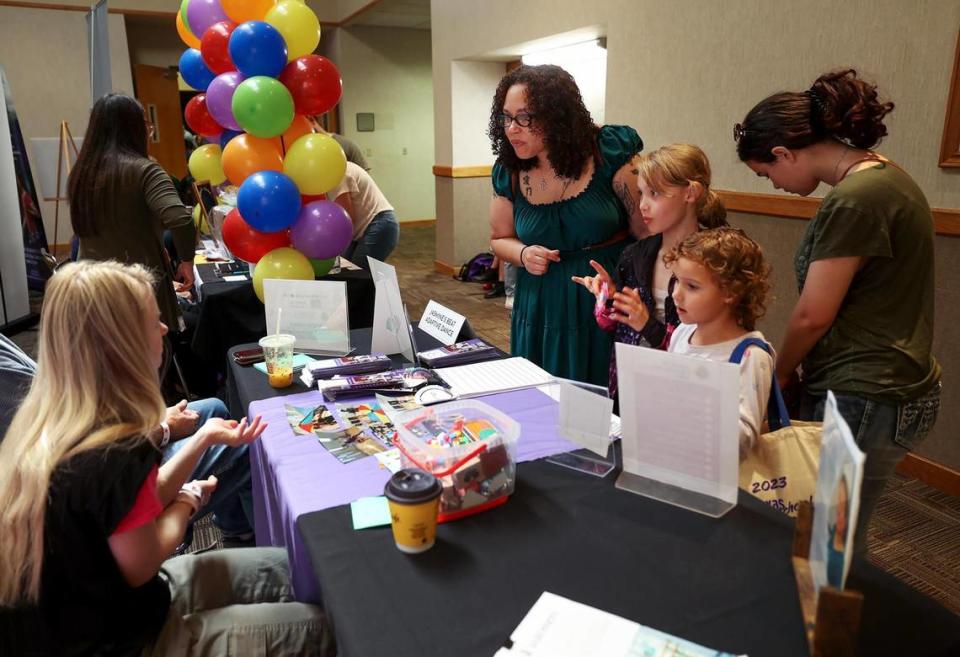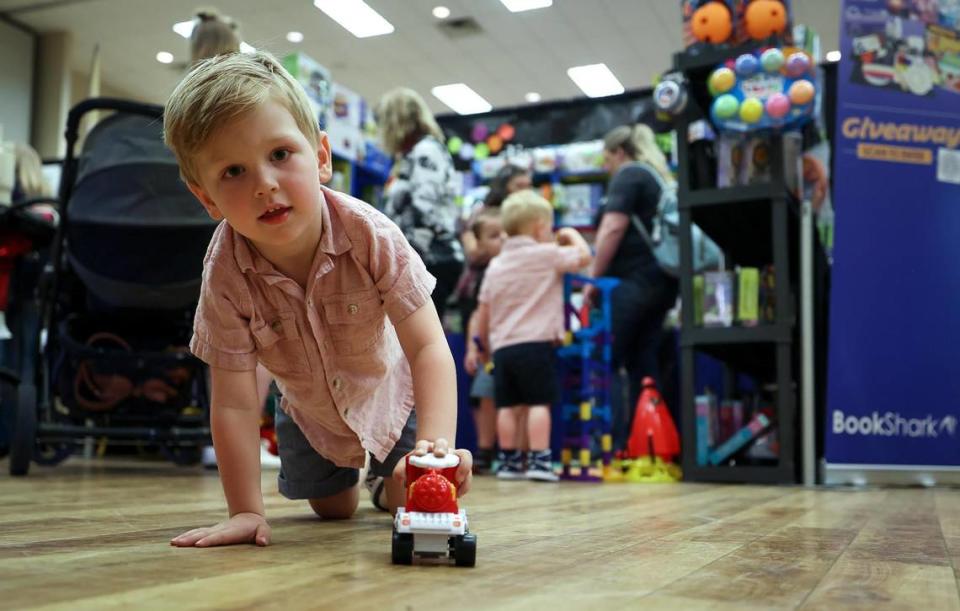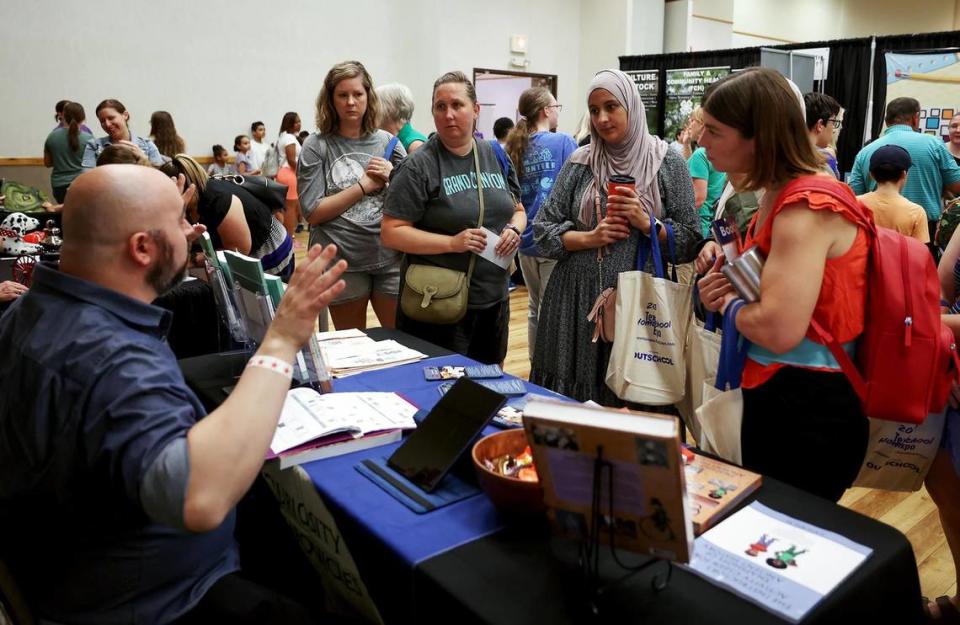More families are leaving Texas’ public schools for home-schooling. Here’s why.
Standing in a conference room in a suburban convention center Friday morning, 6-year-old Raven Edmunds gently stroked a brown ball python as she listened to a zookeeper explain that pythons don’t generally bite, but instead wrap themselves into a tight ball when they feel threatened.
The snake, for its part, handled the attention well, calmly coiling itself around the zookeeper’s hands as she talked to parents about the educational programs the Dallas Children’s Aquarium offers.
Raven and her mom, Haley Edmunds, were two of dozens of home-school students and parents at the Texas Homeschool Expo on Friday morning at the Grapevine Convention Center. Although getting to play with a python was a nice bonus, Raven was at the expo to help her mom pick out instructional materials for second grade.
Raven finished first grade last month, marking the end of her first year as a home-schooler. Edmunds, of Azle, said the transition from the private school where Raven went to kindergarten to home-schooling was a big adjustment, both for mother and daughter.
“It was definitely different, because I had no idea what I was doing,” Edmunds said with a laugh.
Edmunds and her daughter are one of a growing number of Texas families who have left traditional schools in favor of home-schooling over the past three years. Experts say the pandemic was just one of several factors behind that trend.
Already on the rise, home-schooling grows during pandemic
Although home-schooling was already gaining popularity before the pandemic, researchers say interest has grown rapidly over the past three years. In March 2021, a year after COVID outbreaks forced school districts across the country to close their buildings and move instruction online, the U.S. Census Bureau’s Household Pulse Survey noted that the number of families who reported that they were home-schooling doubled between the spring of 2020 to the fall of the same year.
That trend was even sharper among Black families: In the spring of 2020, 3.3% of Black families reported that they were home-schooling their children, about two points lower than the American populace at large. But by the following fall, that number had jumped to 16.1%, a five-fold uptick.
The exact definition of home-schooling makes the magnitude of the trend hard to pin down. A family who enrolls their kids in a public virtual academy and augments the curriculum with field trips and special projects might tell survey-takers they were home-schooling, even though their children are enrolled in a public school and taking classes taught by Texas-certified teachers.

In nearly every school district in the Fort Worth area, the number of students who left the district and switched to home-schooling climbed between the 2019-20 school year, which wasn’t affected by the pandemic until March, and the 2020-21 school year, which most districts began in remote learning, according to TEA records. In Fort Worth ISD, that number climbed by 64%. In Arlington ISD, it climbed by 36%. In Crowley ISD, it nearly doubled.
But those numbers don’t tell the complete picture: Texas only requires school districts to track the number of students who leave in grades 7 and up, meaning state-level data leaves out younger students who disenroll from the public school system. Those figures also don’t include students who began their school careers in home-schooling.
Azle family tries home-schooling to fit daughter’s learning style
Raven didn’t start her school career in home-schooling. Two years ago, she went to Pebbles Preschool and Kindergarten, a private school at Cornerstone Baptist Church in Fort Worth where Edmunds taught preschool. But when the time came to enroll Raven in first grade, Edmunds and her husband knew they’d have to make a decision about where to send her, because Pebbles’ program didn’t go beyond kindergarten.
After talking about their options, Edmunds and her husband decided that home-schooling might be the best fit for Raven’s learning style. They were also concerned about safety in the public school system, she said. So Edmunds left her teaching job and committed to a new role as a home-school mom.
The first year of home-schooling involved a lot of trial and error, Edmunds said, especially in math. Edmunds would put one workbook in front of Raven, and she wouldn’t understand it. So she’d try another that covered essentially the same material but presented it in a different way, and Raven would do better, she said. But Edmunds quickly learned that Raven is a visual learner, so even the best workbooks used on their own didn’t work that well for her.
“She was just going through the motions, but she wasn’t actually retaining it,” Edmunds said.
So Edmunds started mixing pencil-and-paper assignments with hands-on activities using manipulatives, as well as online videos like Bill Nye the Science Guy and Sid the Science Kid. That combination seemed to work best for Raven, Edmunds said. Home-schooling gave her the freedom to explore which options help Raven learn best, then tailor lessons around those instructional styles. That level of individualized instruction wouldn’t be possible in a first-grade classroom, she said.
The fact that Edmunds was a teacher before she was a home-school mom probably gave her an advantage, she said. She was used to working with preschoolers, which is radically different from teaching a first-grader, she said. But she already knew how to structure a lesson and how to tell when her daughter understood the material or when a lesson didn’t work for her. Still, she had to learn a lot, she said.
“It was fun, but it was an adjustment,” she said.
School safety, health concerns among reasons for home-schooling
Peggy Semingson, a professor at the University of Texas at Arlington, has been tracking home-schooling trends since the beginning of the pandemic. Although the state doesn’t yet have data to show whether the growth in home-schooling persisted through the 2022-23 school year, based on what she’s heard anecdotally, Semingson said she suspects that trend has continued.
A variety of factors have led families to home-school their kids, Semingson said. Some pulled out of the public school system because of concerns about safety, either in response to bullying or news of school shootings, she said. Others, especially in the earliest days of the pandemic, opted to keep their kids at home for health reasons. Others had religious or ideological reasons, she said, including objections to what was included in the public school curriculum.
Other families had more proactive reasons for choosing home-schooling over public schools, Semingson said. They saw opportunities that didn’t exist in a formal school setting, and possibilities of enriching their children’s lives, she said.

Semingson said home-schooling can look radically different from one family to the next. Some families use a prescribed, structured curriculum that mimics what students would get in public schools. Others use virtual schooling, which can either look similar to public schools or give parents a way to adopt pieces of a prescribed program and provide the rest themselves through supplemental activities like trips to museums or zoos, she said. Still others have adopted unschooling, a free-form educational model that rejects the structure of a set curriculum and instead emphasizes student-directed learning and projects that allow kids to explore their areas of interest.
Many families also participate in home-schooling co-ops, in which several families join together to hold group classes. That model offers a few advantages, Semingson said. Co-ops often hire teachers to work with students in particular subject areas, which can take pressure off of parents who don’t feel equipped to teach their kids subjects like science and upper-level math. Having students participate in group classes also helps alleviate concerns about socialization, because it gives kids a chance to interact with other children their age, she said.
Families who opt to home-school today have access to resources home-schoolers didn’t have decades ago, Semingson said. Online courses offer opportunities for review and remediation that can help when students are struggling, she said. For example, if a student is having a hard time understanding fractions, parents can connect them with other resources like math learning games, which can help them look at the material in a different way, she said.
“There’s just a lot more instant creative options rather than just a textbook or flash cards and that kind of thing,” she said.

Semingson said she expects interest in home-schooling will continue to grow in the coming years. Across all educational levels, more students and parents are looking for flexibility that the traditional brick-and-mortar public school system struggles to provide, she said. Rather than forcing families into a model that may seem outdated to some, Semingson said, educational providers need to embrace that demand for flexibility and recognize that alternative options may work best for many families.
That being said, state policymakers might have reasonable concerns about how much of an education home-school students actually receive, Semingson said. If home-schooling continues to grow in Texas, she said, she expects to see lawmakers enact measures to ensure that those students aren’t being neglected.
Pandemic influenced parents’ decisions to home-school
Before the pandemic, the reasons most families cited for switching to home-school had to do with concerns over the public school environment, concerns about academics and parents’ desire to provide religious and moral instruction that didn’t exist in public schools, said Jeremy Newman, vice president of policy and engagement for the Texas Home School Coalition, a home-school advocacy group. After the beginning of the pandemic, those reasons stayed largely the same, but the facts behind them changed, he said.
For example, parents’ concerns about the public school environment could take many forms, Newman said. But during the early days of the pandemic, a large number of parents became concerned about how their children’s schools responded to the virus. Parents from opposite ends of the political spectrum arrived at the same conclusion, but for different reasons, he said.
“Some people didn’t like what they felt like was a heavy-handed treatment from their school about COVID. Other people didn’t like what they felt like was lax treatment from their school (about) COVID,” he said. “And the uniform solution for a lot of those people was ‘I’m going to do this myself.’”

Newman said flexibility is one of the main reasons people leave traditional schools and switch to home-schooling. Families with students in traditional schools have to arrange their entire lives around the school schedule, he said. If something in a family’s life goes wrong, like a major illness or a lack of transportation, their schedule may have to change in ways that the public school system can’t accommodate, he said.
Jennifer Morris, a tutor with the Salt Educational Co-op, said the group saw a decline in attendance at the beginning of the pandemic because families were concerned about meeting in person. Since then, the home-school co-op, which meets at Faith Bible Church in DeSoto, has seen growing interest among families in the area, she said.
Many families come to the co-op because they’re looking for a faith-based curriculum that public schools can’t offer, Morris said. Students go to the co-op for classes two days a week, for four periods a day, she said. The co-op isn’t a school, she said. Instructors there are called tutors instead of teachers, and as classes are intended to supplement the instruction students get at home, rather than serving as the only schooling kids get during the week.
The co-op does enrichment activities like field trips and class parties — “just to give them all of the perks of a public school experience without all the negatives,” she said.
Black families represent fast-growing piece of home-school picture
Both in Texas and nationwide, Black families make up the fastest-growing segment of the home-school population. Brian Ray, president of the National Home Education Research Institute, said many of those families left the public education system for the same reasons that other families did — a desire to give their child a better academic experience than they got in public schools or a desire to spend more time together as a family, among other reasons.
But many also said they left to teach their children using a curriculum that centers Black history and culture in ways public school instruction doesn’t, or to escape discriminatory treatment against Black children, and Black boys in particular, that they found in public schools, he said.
Ray said there are indications that growth in interest in home-schooling has continued, although likely not at the rapid rate that it grew in the early days of the pandemic. The list of reasons that families choose to home-school their kids hasn’t changed much over the past 40 years, Ray said, but some reasons may be more or less common at any given time, depending on what’s going on in the world.
After school shutdowns and remote learning caused parents to get more involved in their children’s instruction, there was an uptick in the number of families who said they left traditional education because they were unhappy with what their children were being taught in school, Ray said. Months after school shutdowns ended, he said, more families began to cite concerns about school safety in the wake of violent incidents, including last year’s shooting at Robb Elementary School in Uvalde.
Home-school mom reflects on lessons from first year
Looking back on her first year as a home-school mom, Edmunds, the mother in Azle, said she wishes she’d spent more time researching what resources were available, rather than picking the ones she found first and trying them out.
She also wishes she’d asked for more input from her daughter earlier on. Although Raven is only 6, she has a lot of insight into which instructional styles work best for her, Edmunds said. She can tell her mom what makes sense to her and what doesn’t. That’s important information for Edmunds to have when she picks a curriculum, so she tries to remember to listen to what her daughter has to say about it.
“She can understand how her brain works better than I can,” she said.

